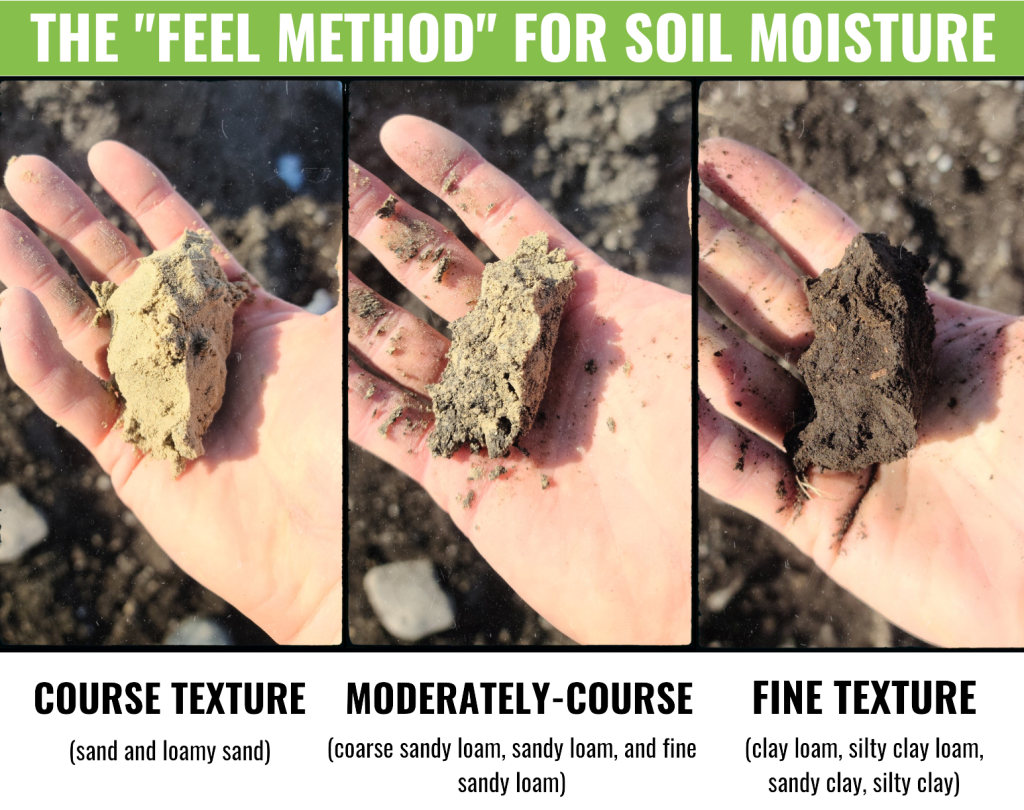WHY SOIL MOISTURE MATTERS
Achieving the proper soil moisture is crucial for ensuring the success of your TELONE™ II fumigation. Proper moisture levels will significantly enhance effectiveness and maximize your results. Too little moisture and the fumigant escapes into the air before doing its job. Too much, and the fumigant can’t move through the soil properly, reducing its effectiveness.
Striking the right balance helps the fumigant spread evenly, stay contained, and deliver maximum efficacy against nematodes; it also helps eliminate off-target exposures. This guide will walk you through assessing and managing soil moisture with practical tips for using the USDA Feel and Appearance Method. Remember, there’s no coming back
from a poor start.
ESSENTIAL MOISTURE GUIDELINES FOR TELONE™ II APPLICATION
- DEEP APPLICATIONS (MORE THAN 18 INCHES): Ensure the soil is moist within 16 inches upward from the injection point.
- SHALLOW APPLICATIONS (LESS THAN 18 INCHES): Moisture must extend from 2 inches below the surface to 12 inches deep.
- IGNORE SURFACE MOISTURE: The top layer of soil dries quickly and doesn’t reflect overall moisture conditions. For accurate results, focus on the moisture content below 2 inches.
- ADJUST FOR SOIL TYPE: Coarser soils, like sands and sandy loams, need more moisture to hold the fumigant. Finer soils, like clay loams, handle fumigant movement better at lower moisture levels. If moisture is too high in finer soils, the fumigant may struggle to spread, reducing effectiveness.
TIPS FOR MANAGING SOIL MOISTURE
- CHECK THE 2-6 INCH ZONE: If this zone is dry, it can limit fumigant sealing. Light irrigation or tillage can bring deeper moisture up to where it’s needed.
- TILLAGE TIMING MATTERS: Do any tillage or field preparation right before fumigation to conserve moisture and prevent unnecessary evaporation.
- PLAN FOR MIXED SOIL TYPES: If your field has varying soil textures, focus on managing moisture in the lightest, most sandy areas to ensure even fumigant movement.
SHOULD YOU IRRIGATE?
- AVOID HEAVY IRRIGATION RIGHT BEFORE FUMIGATION: Too much water can interfere with sealing the fumigant in the soil. If heavy rains precede the application, the best practice is to wait and reassess.
- USE LIGHT IRRIGATION WHEN NEEDED: If surface soil doesn’t provide a good seal, light sprinkler irrigation of 1 to 2 inches before or after fumigation can help seal.
HOW TO USE THE USDA FEEL AND APPEARANCE METHOD
Probes or sensors can also be utilized. This method is a practical, hands-on way to assess soil moisture in the field.
- COLLECT A SOIL SAMPLE: Use a probe, shovel or auger to grab a sample 6 to 12 inches deep.

- TEST THE SOIL BY HAND:
- COURSE SOILS (Sand, Loamy Sand): Soil should form a weak ball that crumbles easily when disturbed.
- LOAMY OR MODERATELY COURSE SOILS (Sandy Loam, Fine Sandy Loam): The soil should hold together when pressed into a ball but not stick between your fingers.
- FINE SOILS (Clay Loam, Silty Clay Loam): The soil should feel soft and pliable but not form a ribbon when pressed between your thumb and forefinger.

BRINGING IT ALL TOGETHER
Managing soil moisture before fumigation is essential to getting the best results from TELONE™ II. Take the time to assess moisture levels accurately using the probes or the USDA Feel and Appearance Method and adjust as needed with light irrigation or tillage. Proper moisture ensures the fumigant stays in the soil where needed, helping you control pests effectively while minimizing vapor loss. With some planning and attention to detail, you’ll be set up for a safe and successful application.
For more information on proper moisture levels and other application information, check out our detailed TELONE™ Application Guide (available for PDF download).
You can also download this blog post information in PDF form, here.
Remember, there’s no coming back from a poor start!
Disclaimer:
The resources and information provided are meant purely for educational discussion, contains only general information about legal matters, and is not to be construed as advice. Please note that any information or resources provided are not legal or regulatory advice, and should not be treated as such. You must not rely on the information provided as an alternative to legal advice from your attorney or other professional services. Teleos Ag encourages readers to consult with counsel, and their local, county, and state regulators. We make no representations or warranties, express or implied, in relation to the information provided through our resources and blog posts. It is the readers responsibility to know the laws related to 1,3- D, appropriate PPE, Licensing, etc., in his or her City, County, State, and Country.
- STORAGE SECURITY FOR TELONE™ by TELEOS - October 16, 2025
- TIP SHEET: PLACARDING FOR BULK SHIPMENT RETURNS - August 15, 2025
- Stewardship Tip Sheet: Tamper-Evident Packaging Requirements - July 14, 2025


